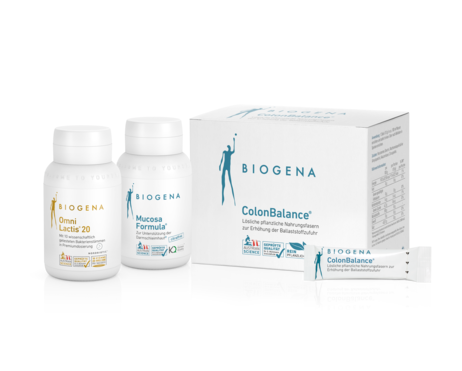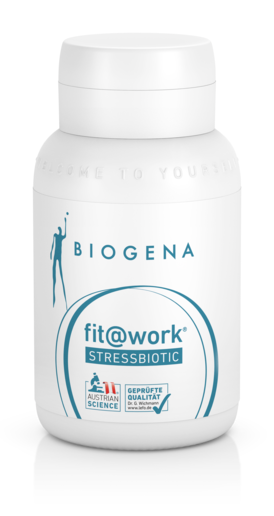Intestinal bacteria
Intestinal bacteria (lactobacteria and bifidobacteria) have been known as popular dietary supplements for many years. With little effort, every person can do a lot for good for their bowel.


Support for the intestinal flora
Things worth knowing about intestinal bacteria
Lactobacteria and bifidobacteria are among the most important residents of the human intestinal system. Our metabolism would not work without microorganisms like this. Researchers believe that the intestine is colonized by millions of bacteria and other microorganisms. Up to 2,000 types of bacteria can be present in a healthy intestinal environment. Lactobacteria and bifidobacteria have a very special role.
In a healthy intestine, lactobacteria belong to the second largest group of building intestinal bacteria. They help with digestion and keep the pH level stable. Both are among the basic requirements of a balanced intestinal flora and contribute significantly to human well-being. In addition to the intestine, lactobacteria also occur in other mucous membranes such as in the mouth or the vagina.
Diversity makes the difference
Lactobacteria and bifidobacteria are gram-positive and acid-tolerant intestinal bacteria. Lactobacteria, also called lactic acid bacteria, belong to the strain of firmicutes. As their name suggests, these bacteria convert sugar into lactic acid. Both the production of lactate and acetate leads to a lower pH value in the gastrointestinal tract. Lactobacteria therefore contribute to inhibiting the growth of other potentially harmful bacteria. Bifidobacteria are part of the actinobacteria strain. Bifidobacteria also produce the short-chain fatty acids acetate and lactate in our gastrointestinal tract, which support our defense against pathogens. Some types of bifidobacteria produce vitamins and help convert food components into bioactive molecules.
The more different types of bacteria colonize the intestines, the more resistant and livelier the intestinal flora. In addition to these desired intestinal residents, there are also some harmful lactobacteria, which include the feared streptococci, for example. Normally, a healthy organism can handle these bacteria well. They only become dangerous if the intestinal flora is already sensitively impaired and the immune system can no longer work sufficiently.
What bacterial strains are there?
Nutritional supplements contain particularly well-researched and proven lactobacteria strains such as
- Lactobacillus acidophilus
- Lactobacillus casei (L. casei)
- Lactobacillus plantarum
- Lactobacillus paracasei
- Lactobacillus rhamnosus
- Bifidobacterium lactis
- Bifidobacterium longum
- Bifidobacterium bifidum
- Bifidobacterium breve
Foods in which lactobacteria and bifidobacteria occur
Humans have lived with and thanks to lactic acid bacteria since the beginning of existence. Incidentally, they discovered the possibilities of preservation during evolution through gentle fermentation with these little helpers. Foods such as fermented milk, kefir, yogurt, cheese, sauerkraut, and also beer and cider were produced.
Today, these foods are used only to a limited extent as suppliers of high-quality strains of lactobacteria and bifidobacteria. The reasons for this are often the industrial processing of food and the addition of other products for preservation.
The tasks in the body
Wherever lactobactobacteria and bifidobacteria occur on the mucous membranes or normal human skin, they are significantly involved in maintaining the optimal pH balance. They create a slightly acidic climate in which other, namely harmful, germs cannot multiply. The pH value is generally 8 in the intestine, 6.5 to 7.2 in the saliva, and 4.5 in the vagina.
These special bacteria achieve this by breaking down substances. In the intestine, it is food and secondary substances that have penetrated the food, such as other bacteria, fungi, or other substances. All these things are made “digestible” with the help of intestinal bacteria, i.e. lactobacteria and bifidobacteria.
In addition, intestinal bacteria play a major role in the splitting of food. They prefer to convert carbohydrates into easily usable lactic acid. As a side effect of this conversion, the intestine is optimally kept in acidic balance. By contrast, if we eat too many carbohydrates and do not have enough lactobacteria available, the intestine can quickly acidify and the growth of harmful bacteria can be promoted.
A further task of the lactobactobacteria and bifidobacteria is the production of short-chain fats, which are used in particular for the regeneration and energy production of the intestinal mucosa. Incidentally, if the intestine is in balance, this usually also has a positive effect on the other mucous membranes in the body.
Intestinal environment
Colonization with bacteria is crucial for our intestinal environment. How many and which bacterial strains are present and which lactobactobacteria and bifidobacteria do we eat? All of this plays a role in maintaining the balance of this sensitive organ.
If the intestine is out of balance
Whenever this highly complex and sensitive biosystem is disrupted, the consequences can quickly become noticeable. Less serious symptoms may be
- dry skin and dull hair
- Itching and flaking of the skin
- Flatulence and regurgitation
If these early warning signals are overlooked, further disturbances can form in the long term. In the meantime, it is also known that intestinal health has a direct influence on the performance and resistance of the brain. However, this is not all. A disturbed intestinal climate is repeatedly associated with the development of inflammatory processes of all kinds.
Additional intake of lactobacteria and bifidobacteria ...
- can have a positive effect on the health of the intestinal flora.
- can improve digestion in the long term.
- can ensure better utilisation of food.
- can stabilise the immune system.
- can significantly improve irritable bowel syndrome.
- can lead to a greater sense of well-being and performance overall.













